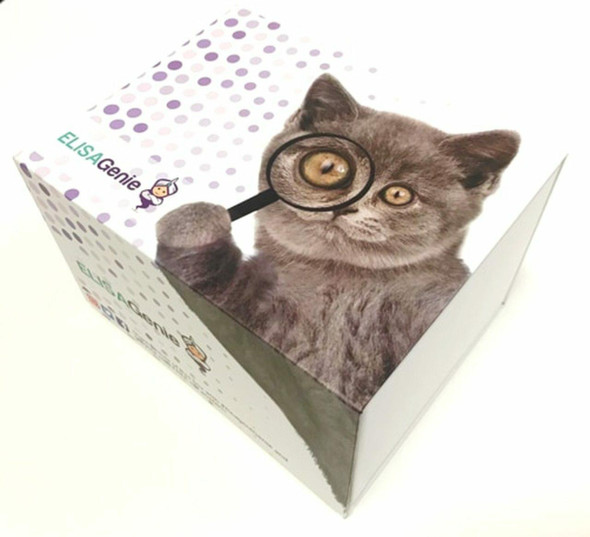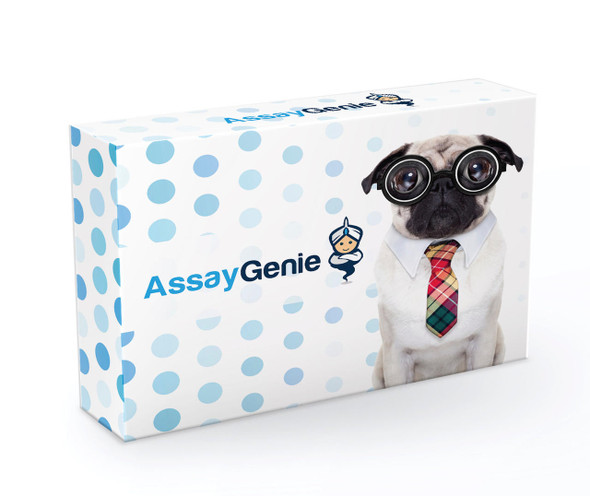Rat Fibronectin ELISA Kit (RTFI00017)
- SKU:
- RTFI00017
- Product Type:
- ELISA Kit
- Size:
- 96 Assays
- Uniprot:
- P04937
- Sensitivity:
- 0.094ug/ml
- Range:
- 0.156-10ug/ml
- ELISA Type:
- Sandwich
- Synonyms:
- FN, Fibronectin, FN1, CIG, ED-B, FINC, FNZ, GFND, GFND2, LETS, MSF
- Reactivity:
- Rat
Description

 " target=_blank">Datasheetsystem_update_altMSDS
" target=_blank">Datasheetsystem_update_altMSDSRat Fibronectin ELISA Kit
The Rat Fibronectin ELISA Kit is a highly sensitive and specific assay designed for the precise quantification of fibronectin levels in rat samples, including serum, plasma, and cell culture supernatants. This kit provides reliable and reproducible results, making it an ideal tool for various research applications.Fibronectin is a key glycoprotein that plays a critical role in cell adhesion, migration, and tissue repair processes. Abnormal fibronectin levels have been implicated in numerous diseases, including cancer, fibrosis, and cardiovascular disorders.
As such, monitoring fibronectin levels in experimental models is essential for understanding disease pathology and developing potential therapeutic interventions.With its high performance and convenience, the Rat Fibronectin ELISA Kit is a valuable resource for researchers investigating fibronectin biology and its implications in disease. Trust in this kit for accurate, quantitative analysis of fibronectin levels in rat samples, advancing your research efforts in the field of cell biology and disease mechanisms.
| Product Name: | Rat FN (Fibronectin) ELISA Kit |
| Product Code: | RTFI00017 |
| Size: | 96 Assays |
| Target: | Rat FN |
| Alias: | FN, Fibronectin, FN1, CIG, ED-B, FINC, FNZ, GFND, GFND2, LETS, MSF |
| Reactivity: | Rat |
| Detection Method: | Sandwich ELISA, Double Antibody |
| Sensitivity: | 0.094ug/ml |
| Range: | 0.156-10ug/ml |
| Storage: | 4°C for 6 months |
| Note: | For Research Use Only |
| Recovery: | Matrices listed below were spiked with certain level of Rat FN and the recovery rates were calculated by comparing the measured value to the expected amount of Rat FN in samples. | ||||||||||||||||
| |||||||||||||||||
| Linearity: | |||||||||||||||||
| |||||||||||||||||
| Intra-Assay: | CV <8% | ||||||||||||||||
| Inter-Assay: | CV <10% |
| Uniprot: | P04937 |
| UniProt Protein Function: | FN1: Fibronectins bind cell surfaces and various compounds including collagen, fibrin, heparin, DNA, and actin. Fibronectins are involved in cell adhesion, cell motility, opsonization, wound healing, and maintenance of cell shape. Defects in FN1 are the cause of glomerulopathy with fibronectin deposits type 2 (GFND2); also known as familial glomerular nephritis with fibronectin deposits or fibronectin glomerulopathy. GFND is a genetically heterogeneous autosomal dominant disorder characterized clinically by proteinuria, microscopic hematuria, and hypertension that leads to end-stage renal failure in the second to fifth decade of life. 15 isoforms of the human protein are produced by alternative splicing. |
| UniProt Protein Details: | Protein type:Secreted; Motility/polarity/chemotaxis; Cell adhesion; Secreted, signal peptide Cellular Component: extracellular matrix; proteinaceous extracellular matrix; extracellular space; fibrinogen complex; apical plasma membrane; extracellular region; ER-Golgi intermediate compartment; basement membrane; basal lamina Molecular Function:heparin binding; integrin binding; protein binding; protease activator activity; protease binding; extracellular matrix structural constituent; mercury ion binding Biological Process: integrin activation; extracellular matrix organization and biogenesis; ossification; wound healing; positive regulation of chemotaxis; positive regulation of axon extension; cell-matrix adhesion; response to glucocorticoid stimulus; glial cell migration; regulation of cell shape; cell activation; response to ozone; acute-phase response; response to wounding; calcium-independent cell-matrix adhesion; cell-substrate junction assembly; angiogenesis; peptide cross-linking; cell adhesion; positive regulation of cell migration; negative regulation of apoptosis |
| NCBI Summary: | extracellular matrix component; may play a role in fibrosis and tumor metastasis [RGD, Feb 2006] |
| UniProt Code: | P04937 |
| NCBI GenInfo Identifier: | 120178 |
| NCBI Gene ID: | 25661 |
| NCBI Accession: | P04937.2 |
| UniProt Related Accession: | P04937 |
| Molecular Weight: | |
| NCBI Full Name: | Fibronectin |
| NCBI Synonym Full Names: | fibronectin 1 |
| NCBI Official Symbol: | Fn1 |
| NCBI Official Synonym Symbols: | fn-1; FIBNEC |
| NCBI Protein Information: | fibronectin |
| UniProt Protein Name: | Fibronectin |
| Protein Family: | Fibronectin |
| UniProt Gene Name: | Fn1 |
| UniProt Entry Name: | FINC_RAT |
| Step | Procedure |
| 1. | Set standard, test sample and control (zero) wells on the pre-coated plate respectively, and then, record their positions. It is recommended to measure each standard and sample in duplicate. Wash plate 2 times before adding standard, sample and control (zero) wells! |
| 2. | Aliquot 0.1ml standard solutions into the standard wells. |
| 3. | Add 0.1 ml of Sample / Standard dilution buffer into the control (zero) well. |
| 4. | Add 0.1 ml of properly diluted sample ( Human serum, plasma, tissue homogenates and other biological fluids.) into test sample wells. |
| 5. | Seal the plate with a cover and incubate at 37°C for 90 min. |
| 6. | Remove the cover and discard the plate content, clap the plate on the absorbent filter papers or other absorbent material. Do NOT let the wells completely dry at any time. Wash plate X2. |
| 7. | Add 0.1 ml of Biotin- detection antibody working solution into the above wells (standard, test sample & zero wells). Add the solution at the bottom of each well without touching the side wall. |
| 8. | Seal the plate with a cover and incubate at 37°C for 60 min. |
| 9. | Remove the cover, and wash plate 3 times with Wash buffer. Let wash buffer rest in wells for 1 min between each wash. |
| 10. | Add 0.1 ml of SABC working solution into each well, cover the plate and incubate at 37°C for 30 min. |
| 11. | Remove the cover and wash plate 5 times with Wash buffer, and each time let the wash buffer stay in the wells for 1-2 min. |
| 12. | Add 90 µL of TMB substrate into each well, cover the plate and incubate at 37°C in dark within 10-20 min. (Note: This incubation time is for reference use only, the optimal time should be determined by end user.) And the shades of blue can be seen in the first 3-4 wells (with most concentrated standard solutions), the other wells show no obvious color. |
| 13. | Add 50 µL of Stop solution into each well and mix thoroughly. The color changes into yellow immediately. |
| 14. | Read the O.D. absorbance at 450 nm in a microplate reader immediately after adding the stop solution. |
When carrying out an ELISA assay it is important to prepare your samples in order to achieve the best possible results. Below we have a list of procedures for the preparation of samples for different sample types.
| Sample Type | Protocol |
| Serum: | If using serum separator tubes, allow samples to clot for 30 minutes at room temperature. Centrifuge for 10 minutes at 1,000x g. Collect the serum fraction and assay promptly or aliquot and store the samples at -80°C. Avoid multiple freeze-thaw cycles. If serum separator tubes are not being used, allow samples to clotovernight at 2-8°C. Centrifuge for 10 minutes at 1,000x g. Removeserum and assay promptly or aliquot and store the samples at-80°C. Avoid multiple freeze-thaw cycles. |
| Plasma: | Collect plasma using EDTA or heparin as an anti-coagulant. Centrifuge samples at 4°C for 15 mins at 1000 × g within 30 mins of collection. Collect the plasma fraction and assay promptly or aliquot and store the samples at -80°C. Avoid multiple freeze-thaw cycles.Note: Over haemolysed samples are not suitable for use with this kit. |
| Urine & Cerebrospinal Fluid: | Collect the urine (mid-stream) in a sterile container, centrifuge for 20 mins at 2000-3000 rpm. Remove supernatant and assay immediately. If any precipitation is detected, repeat the centrifugation step. A similar protocol can be used for cerebrospinal fluid. |
| Cell Culture Supernatant: | Collect the cell culture media by pipette, followed by centrifugation at 4°C for 20 mins at 1500 rpm. Collect the clear supernatant and assay immediately. |
| Cell Lysates: | Solubilize cells in lysis buffer and allow to sit on ice for 30 minutes. Centrifuge tubes at 14,000 x g for 5 minutes to remove insoluble material. Aliquot the supernatant into a new tube and discard the remaining whole cell extract. Quantify total protein concentration using a total protein assay. Assay immediately or aliquot and store at ≤ -20°C. |
| Tissue Homogenates: | The preparation of tissue homogenates will vary depending upon tissue type. Rinse tissue with 1X PBS to remove excess blood & homogenizein 20ml of 1X PBS (including protease inhibitors) and store overnight at ≤ -20°C. Two freeze-thaw cycles are required to break the cell membranes. To further disrupt the cell membranes you can sonicate the samples. Centrifuge homogenates for 5 mins at 5000xg. Remove the supernatant and assay immediately or aliquot and store at -20°C or-80°C. |
| Tissue Lysates: | Rinse tissue with PBS, cut into 1-2 mm pieces, and homogenize with a tissue homogenizer in PBS. Add an equal volume of RIPA buffer containing protease inhibitors and lyse tissues at room temperature for 30 minutes with gentle agitation. Centrifuge to remove debris. Quantify total protein concentration using a total protein assay. Assay immediately or aliquot and store at ≤ -20 °C. |
| Breast Milk: | Collect milk samples and centrifuge at 10,000 x g for 60 min at 4°C. Aliquot the supernatant and assay. For long term use, store samples at -80°C. Minimize freeze/thaw cycles. |
| Younis et al. | Inactivation of Wnt/β-catenin/renin angiotensin axis by tumor necrosis factor-alpha inhibitor, infliximab, ameliorates CKD induced in rats | Biochem Pharmacol. 185:114426 (2021) | Pub Med: 33482150 |
| Younis et al. | Potential therapeutic efficacy of pachymic acid in chronic kidney disease induced in rats: role of Wnt/β-catenin/renin-angiotensin axis | J Pharm Pharmacol . (2021) | Pub Med: 34549301 |






